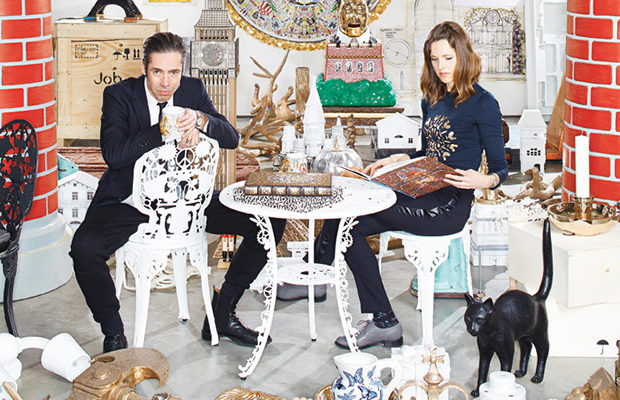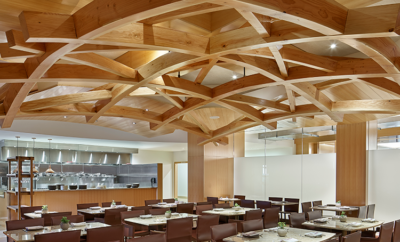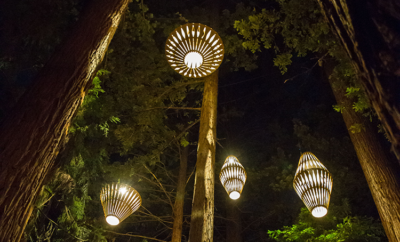 Job Smeets and Nynke Tynagel of Studio Job. Photo by Rene van der Hulst for Living Magazine Italia.
Job Smeets and Nynke Tynagel of Studio Job. Photo by Rene van der Hulst for Living Magazine Italia.
Feature
Beyond Baroque: The World of Studio Job
SIPPING TEA AT ROBERT, the rooftop restaurant at the Museum of Arts and Design, Job Smeets and Nynke Tynagel, the duo behind Studio Job, appear poised and relaxed in spite of barely having a moment to rest since arriving in New York. But, then again, they are accustomed to this busy pace. The trip kicked off with the press preview and then the opening of Studio Job MAD HOUSE, the designers’ first solo museum exhibition in America, which has transformed two floors of the building into an imagined “crazy collector’s home,” Tynagel says, that shakes off the prototypical sterile “museum feeling.” And there is certainly nothing cookie-cutter or muted or conventional about the work created by Smeets and Tynagel’s Netherlands and Belgium-based atelier.
Downstairs, dreamlike lighting, furniture, sculpture, and other objects created over the past sixteen years populate galleries covered in custom Studio Job wallpaper and floor coverings resembling, respectively, bricks and white-hued parquetry. Wandering through the space you feel as if you’ve slipped down the rabbit hole and found yourself in Alice’s Wonderland, where each piece—an amalgam of sculpture and object, art and design—tells a story or could even come alive. And some do: the polished bronze and gilded Horse Bust (Chess Piece) doubles as a vacuum cleaner. Playful and allegorical, the pieces on display also demonstrate Studio Job’s focus on superlative craftsmanship: whether it is a lamp from its Industry series (2010) in the form of a wrecking ball—made of patinated bronze, handblown glass, and LED light fittings—or the polished and patinated bronze, aluminum, and gilded Train Crash, representing the dissolution of Tynagel and Smeets’s romantic relationship.
Studio Job is ubiquitous these days. The atelier’s ornate, meticulously designed, and often irreverent work can be found in countless galleries, museums, showrooms, and stores around the world, from New York City to Milan to Wuzhen, China, taking the form of one-of-a-kind sculptural pieces, product design, corporate identity materials, fashion, and more.
Smeets and Tynagel first met at the Design Academy Eindhoven in the Netherlands. Toward the end of her studies, Tyngel began an internship at Smeets’s studio, and the two of them, who were already in a romantic relationship, discovered they were also compatible partners in design, and so upon her graduation in 2000 they officially joined forces. Like so many successful partner ships, theirs is defined by a balance of different skill sets and tastes that, when fused together, produce work that is congruent yet eclectic, polished yet rabblerousing. “We are two different characters and we have different talents, so we complement each other well in the work and in life,” Tynagel explains.
“Her background is more graphical, and my background is more conceptual or three-dimensional or what ever,” Smeets says. “I am more like an art director and she is more a designer. I am a really bad art director and she is a really good designer.”
Eschewing the dominant pull of modernism and embracing a more opulent and baroque aesthetic, Studio Job at first encountered its fair share of resistance and criticism from the design world. People were uncertain how to categorize their work: is it art or design? “When we started no one wanted to work with us because they hated our work,” Smeets recalls. “At the design academy, what we got taught was modernism—I don’t know how but we kind of got liberated from that frame. And it took a lot of time, but now we are at the stage where the producers trust us, which is a perfect situation.”
While Tynagel and Smeets recognize modernism’s place in the land scape of design and the need for functional objects, they always adhered to their own sensibilities and interests. “Normally a young designer goes to a production house, gets his design produced, and then it is distributed to the market—totally following the identity and the design possibilities or skills or production methods of the producer,” Smeets says. “The modernist always says that he likes to work within the limited possibilities that a producer can produce. We never took that as the truth. We always found that we wanted to work within the limitations of our brain—it is much more interesting.”
The roughly twenty-person studio is a lean and industrious operation that employs a range of talented artisans and craftsmen to create the work—from stained glass and marquetry to bronze casting and gilding. This multifarious approach is also reflected in the types of projects they choose to take on. “We have kind of a renaissance attitude. We are a very multidisciplinary company—there are really not any boundaries” Smeets says. “We have done corporate identity work for Godiva but then we do public sculptures. The diversity makes it exciting, and the diversity also makes it maybe innovative.”
And Smeets and Tynagel plan on keeping their studio small to maintain the high quality of design and the intimacy of their team. “It is quite a good little machine. All different guys and girls. The team is the core of our business. A good team is everything,” Smeets says.
Coinciding with the MAD exhibition, Studio Job’s second mono graph, Studio Job: Monkey Business, with contributions by Carpenters Workshop Gallery, was published by Rizzoli in March. The book is a capsule of the last five years of the atelier’s work, featuring two hundred sketches, concept renderings, and photographs.
New York is just one stop on Studio Job’s packed travel itinerary. Next up, they’ll land in Milan, where a number of collaborative projects with renowned design brands are being launched, including a decorative mosaic for Bisazza, the Comtoise clock for Alessi (the first of a new series), and an installation titled Howling Wolf in association with Colombostile, among several others.
Once an industry outsider, Studio Job is now a darling of the design world, its moxie and roguish humor much sought after to bring levity, nuance, and verve to any project, from one-of-a-kind furnishings to corporate packaging to private com missions.
Even with all this attention, Smeets and Tynagel remain self-deprecating. As we finished our tea at Robert and headed downstairs, a woman entered the elevator with us and asked what floor the MAD House exhibition was on. Smeets smiled and said, “Don’t go there. It’s crap.” The woman laughed, and having a hunch she was being played with and enjoying it, said, “Let me guess, is one of you the designer?”

For its solo exhibition at MAD, Studio Job transformed the galleries by creating custom-designed parquet wood floorboards and brick wallpaper. This installation view shows three works (left to right): Bavaria Screen, 2008; Horse Bust (Chess Piece), 2014; Robber Baron Safe, 2007. Photo by Butcher Walsh/courtesy of Museum of Arts and Design.












